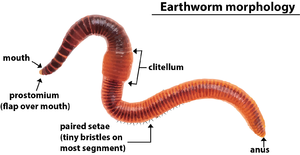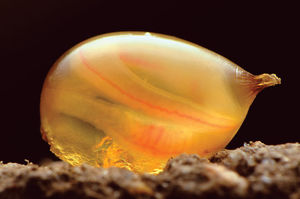Earthworm: Difference between revisions
No edit summary |
No edit summary |
||
| Line 15: | Line 15: | ||
==Reproduction== | ==Reproduction== | ||
[[File:caccoon.jpg|right|thumb]] | |||
Earthworms can only produce sexually, not asexually. The popular myth that if one cuts an earthworm in half, it will regenerate into two earthworms is '''false'''. While earthworms can regenerate small parts of their bodies, they cannot be split into two. Earthworms have both male and female sexual organs, but still need a partner to reproduce. The clitellum is the slightly discolored segment about one-third of the body length away from the head that produces mucous that aids with mating. The worms line up in opposite directions and exchange sperm, using the excreted mucous as a protectant. If the sperm travels appropriately through the mucous it will arrive at the eggs, and fertilize them. The fertilized eggs are then deposited in a mucous cocoon, where they develop into baby worms over a period of a few weeks. | Earthworms can only produce sexually, not asexually. The popular myth that if one cuts an earthworm in half, it will regenerate into two earthworms is '''false'''. While earthworms can regenerate small parts of their bodies, they cannot be split into two. Earthworms have both male and female sexual organs, but still need a partner to reproduce. The clitellum is the slightly discolored segment about one-third of the body length away from the head that produces mucous that aids with mating. The worms line up in opposite directions and exchange sperm, using the excreted mucous as a protectant. If the sperm travels appropriately through the mucous it will arrive at the eggs, and fertilize them. The fertilized eggs are then deposited in a mucous cocoon, where they develop into baby worms over a period of a few weeks. | ||
==Ecology== | ==Ecology== | ||
Revision as of 16:07, 27 April 2021
Overview
The Earthworm is the common name for invertebrates in the family Lumbricina, which includes about 33 different species. They have other folk names such as nightcrawler, angleworm, dewworm, rainworm, etc. They show the basic tube within a tube body type, with segmentation all along their body, each segment called annuli. Each external segment has corresponding internal segmentation and setae/bristles to help with movement. They move by contracting and extending circumferential and longitudinal muscles that are in each segment, as well as using the setae on every segment to get a grip. Earthworms breathe through their skin, and their whole body is covered with a mucous layer that protects from desiccation (i.e. drying out). They have no eyes, instead using cells on the outside of their body that are light sensitive. They are hermaphrodites, each earthworm exhibiting both male and female sexual organs. Earthworms live in temperate and tropical soils all over the world, anywhere there is appropriate water content and temperature. Earthworm diet includes any organic matter they encounter, like plant matter, fungi, bacteria, or any other organism small enough to be eaten. Their digestive tract is one way, they eat with their mouth on one end and excrete waste at the other end of their body. The same muscles that allow for their movement through soil also push their food through their digestive system.
Scientific Classification

Kingdom - Animalia
Phylum - Annelida
Class - Clitellata
Order - Opisthopora
Suborder - Lumbricina
Reproduction

Earthworms can only produce sexually, not asexually. The popular myth that if one cuts an earthworm in half, it will regenerate into two earthworms is false. While earthworms can regenerate small parts of their bodies, they cannot be split into two. Earthworms have both male and female sexual organs, but still need a partner to reproduce. The clitellum is the slightly discolored segment about one-third of the body length away from the head that produces mucous that aids with mating. The worms line up in opposite directions and exchange sperm, using the excreted mucous as a protectant. If the sperm travels appropriately through the mucous it will arrive at the eggs, and fertilize them. The fertilized eggs are then deposited in a mucous cocoon, where they develop into baby worms over a period of a few weeks.
Ecology
References
[1] "Earthworm" Wikipedia, Retrieved April 27, 2021, from https://en.wikipedia.org/wiki/Earthworm
[2] "Earthworm" National Geographic, Retrieved April 27, 2021, from https://www.nationalgeographic.com/animals/invertebrates/facts/common-earthworm
[3] Edwards, Clive A. "Earthworms" Natural Resources Conservation Service Soils, USDA, Retrieved April 27, 2021, from https://www.nrcs.usda.gov/wps/portal/nrcs/detailfull/soils/health/biology/?cid=nrcs142p2_053863
[4] "Earthworm Biology – The Science of the Natural Decomposers" BiologyWise, Retrieved April 27, 2021, from https://biologywise.com/earthworm-biology
[5] Painter, Tammie. "How Do Earthworms Reproduce?" Sciencing.com, Retrieved April 27, 2021, from https://sciencing.com/bring-the-outdoors-inside-with-these-nature-kits-for-kids-13763822.html
[6] https://animals.howstuffworks.com/animal-facts/earthworm3.htm